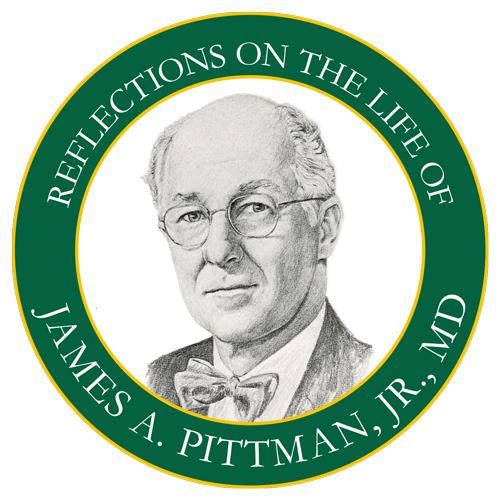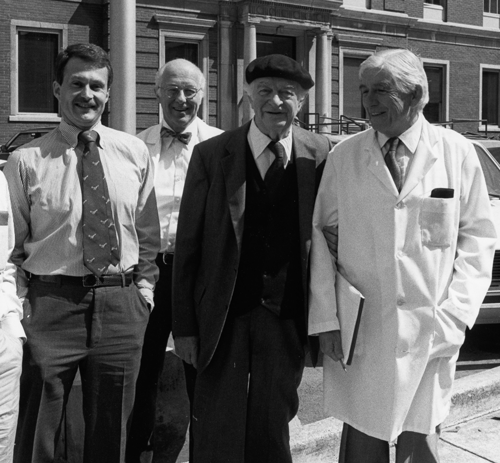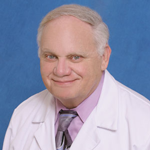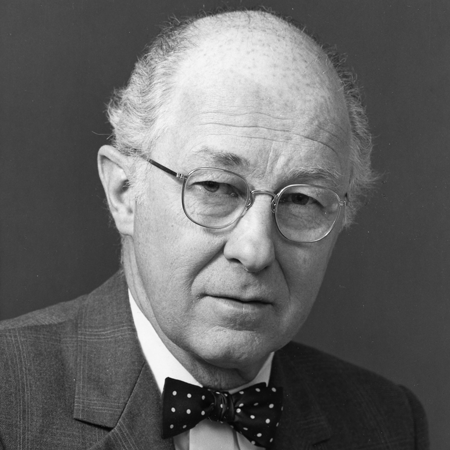 In summer 1967, prior to commencing my medical education, I had the great good fortune to encounter James A. Pittman, Jr., MD, through a summer job in his laboratory in the Nuclear Medicine Section of the VA Hospital. From the moment of our first meeting, I was struck by his breadth of knowledge, candor, enthusiasm and, most importantly, his kindness. This introduction to endocrinology and clinical research later became my life’s work with his assistance.
In summer 1967, prior to commencing my medical education, I had the great good fortune to encounter James A. Pittman, Jr., MD, through a summer job in his laboratory in the Nuclear Medicine Section of the VA Hospital. From the moment of our first meeting, I was struck by his breadth of knowledge, candor, enthusiasm and, most importantly, his kindness. This introduction to endocrinology and clinical research later became my life’s work with his assistance.
Dr. Pittman had noted a significant decline in the normal range for radioactive iodine uptake over the preceding 10 years or so, and suspected increased iodine in the environment as a cause. We documented a 30 to 40 percent decrease in normal values, and verified a significant increase in 24-hour urinary iodine excretion supporting this hypothesis. He had somehow learned that iodine had recently been added to the leavening process of bread. Happily, a bakery was located a block from the VA Hospital. I was dispatched to collect samples at various points along the baking process. The smells there were wonderful, adding to the vivid nature of the memory. Indeed, bread appeared to be the primary variable which had changed during this period. This approach later became part of the worldwide effort to attack the problem of iodine deficiency and developing countries.
 From left, Richard Marchase, Jim Pittman, Nobelist Linus Pauling and Joseph Volker, 1986This work ultimately culminated in a publication in the New England Journal of Medicine in 1969. True to his generous spirit, he included me as one of the authors on this publication, which became widely cited and has always been one of the highlights of my career. He allowed me to present the data at the Southern Section of the American Federation of Clinical Research in New Orleans, and this helped significantly in launching my academic career. His enthusiasm, particularly all things thyroid related, was infectious. I continued to work with him throughout the four years of my medical education in Birmingham. Although my interests later shifted to diabetes and this has become my life’s work, the foundation I received working with Jim and the other highly skilled endocrinologists in Birmingham at that time, led me to a wonderful career which I am still enjoying.
From left, Richard Marchase, Jim Pittman, Nobelist Linus Pauling and Joseph Volker, 1986This work ultimately culminated in a publication in the New England Journal of Medicine in 1969. True to his generous spirit, he included me as one of the authors on this publication, which became widely cited and has always been one of the highlights of my career. He allowed me to present the data at the Southern Section of the American Federation of Clinical Research in New Orleans, and this helped significantly in launching my academic career. His enthusiasm, particularly all things thyroid related, was infectious. I continued to work with him throughout the four years of my medical education in Birmingham. Although my interests later shifted to diabetes and this has become my life’s work, the foundation I received working with Jim and the other highly skilled endocrinologists in Birmingham at that time, led me to a wonderful career which I am still enjoying.
Later, after I completed my training and felt that I was “grown up,” I felt comfortable calling him Jim. This is more difficult than it might seem, having grown up in the South in the 1950s. However, from the moment of our first meeting, Jim never treated me as anything other than a colleague and collaborator. I relate this story, in part to illustrate what I think is one of his most unique, and amazing characteristics. He always seemed to be more interested in furthering the career of his students and junior colleagues ahead of his own. He seemed to take the greatest pleasure in seeing them succeed. In a highly competitive academic world, this was truly unique. The “pecking order” was simply never important to him. This has had a lasting impression on me and imparted a strong commitment to teaching and supporting my younger colleagues.
Early on, he got to work on arranging an endocrinology fellowship for me at Vanderbilt, to which I eventually moved in 1976, working with Drs. David Orth and Grant Liddle, two other giants of endocrinology.
Several years into my training, Jim nominated me for membership in the American Thyroid Association. At that time, the entry requirements were fairly strict and I was not elected the first time around. Jim took this as a personal quest to “right a wrong.” He lobbied a number of his friends and colleagues in the association on my behalf. It was really quite interesting to see him work the room. He introduced me personally to every member he could. He was a master at this. I later was admitted to the organization and have remained a member, in part in tribute to him and his efforts on my behalf.
Jim continued to be a great friend and supporter throughout most of my career, although we never again worked directly together. I kept up with him through endocrine meetings and mutual friends such as Dr. Jerry Hershman, who Jim recruited as a young faculty member around 1969. Jerry set up our first TSH radioimmunoassay in Birmingham, which was an exciting event in endocrinology and thyroid disease.
I moved to San Diego for internal medicine training, and continue to live and work there. It has been wonderful to share this with my lovely wife, Kay, whom I met in microbiology class in Birmingham in 1969. However, my roots both personally and professionally remain in Birmingham.
If a man’s life is judged primarily by the number of lives he has touched and enriched, then Jim Pittman’s life was clearly rich indeed, and we are all better for having known him.
 George E. Dailey, III, MD, is Medical Director at Scripps Whittier Diabetes Institute and Head of Diabetes Research and Senior Consultant for the Division of Diabetes and Endocrinology at Scripps Clinic in La Jolla, Calif. He also serves as Clinical Professor of Medicine, University of California San Diego. He received the MD degree from the School of Medicine at UAB in 1971, followed by internal medicine residency and Chief Residency at UCSD and endocrinology fellowship at Vanderbilt University School of Medicine. He is a founding board member of the American Association of Clinical Endocrinologists and is the author of 95 publications. His awards include Master of the American College of Endocrinology.
George E. Dailey, III, MD, is Medical Director at Scripps Whittier Diabetes Institute and Head of Diabetes Research and Senior Consultant for the Division of Diabetes and Endocrinology at Scripps Clinic in La Jolla, Calif. He also serves as Clinical Professor of Medicine, University of California San Diego. He received the MD degree from the School of Medicine at UAB in 1971, followed by internal medicine residency and Chief Residency at UCSD and endocrinology fellowship at Vanderbilt University School of Medicine. He is a founding board member of the American Association of Clinical Endocrinologists and is the author of 95 publications. His awards include Master of the American College of Endocrinology. 